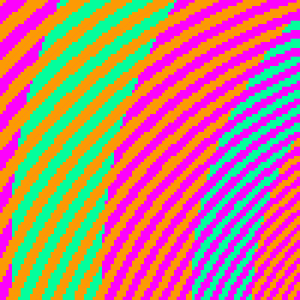One More Time: Another Vivid Illustration That What There Is to Is, Isn’t Exactly What We Thought It Is
What you are seeing above is one of those optical demonstrations that shows us just how shaky is our hold on reality.
The graphic was apparently created by one Akikoshi Kitaoka and posted on his Buzzhunt blog. Then Richard Wiseman posted it on his blog. Which is where Phil Plait, the Bad Astronomy blogger in Discover Magazine, found it. Then Jamais Cascio found it and posted it on his Open the Future blog. And now it appears on Thinkologist and who knows where else by now. I have to think it is going to show up on a gazillion other blogs because it is such an astonishing example of our mind and eyes playing nasty tricks on our God-given right to believe what we see is the truth, the whole truth and nothing but the truth.
After putting Kitaoka’s visual trickery to the test, Cascio flatly states, “In other words, your brain hates you.”
Now, let’s get to the illustration. It appears to show green and blue spirals. But the reality is that the apparent green and apparent blue spirals are exactly the same color!
Since Plait had already done the test for us, I didn’t bother, but I could have done the same thing (and so can you!). He loaded the image in Photoshop and color-checked the two spirals. He confirmed that they are the same color: (for Doubting Thomases, RGB 0, 255, 150 in both spirals).
Plait explains, “The reason they look different colors is because our brain judges the color of an object by comparing it to surrounding colors. In this case, the stripes are not continuous as they appear at first glance. The orange stripes don’t go through the ‘blue’ spiral, and the magenta ones don’t go through the ‘green’ one.” He then zoomed in on the graphic to make all this clearer. And continued:
“See? The orange stripes go through the ‘green’ spiral but not the ‘blue’ one. So without us even knowing it, our brains compare that spiral to the orange stripes, forcing it to think the spiral is green. The magenta stripes make the other part of the spiral look blue, even though they are exactly the same color. If you still don’t believe me, concentrate on the edges of the colored spirals. Where the green hits the magenta it looks bluer to me, and where the blue hits the orange it looks greener. Amazing.
“The overall pattern is a spiral shape because our brain likes to fill in missing bits to a pattern. Even though the stripes are not the same color all the way around the spiral, the overlapping spirals makes our brain think they are. The very fact that you have to examine the picture closely to figure out any of this at all shows just how easily we can be fooled.
“This is why I tell people over and over again: you cannot trust what you see even with your own eyes. Your eyes are not cameras faithfully taking pictures of absolute truth of all that surrounds you. They have filters, and your brain has to interpret the jangled mess it gets fed. Colors are not what they appear, shapes are not what they appear (that zoomed image above is square, believe it or not), objects are not what they appear.
“So the next time someone swears they saw Jesus, or a UFO, or a ghost, show them this picture. What you see in life is absolutely and provably not what you get.”
All this reminds me of the musical illlusions that Daniel J. Levitin wrote about in This Is Your Brain on Music: The Science of a Human Obsession. He reported: “In piano works such as Sindig’s ‘The Rustle of Spring’ or Chopin’s Fantasy-Impromptu in C-sharp Minor, op. 66, the notes go by so quickly that an illusory melody emerges. Play the tune slowly and it disappears. Due to stream segregation, the melody ‘pops out’ when the notes are close enough together in time—the perceptual system holds the notes together—but the melody is lost when its notes are too far apart in time. As studied by Bernard Lortat-Jacob at the Musée de l’Homme in Paris, the Quintina (literally ‘fifth one’) in Sardinian a capella vocal music also conveys an illusion: A fifth female voice emerges from the four male voices when the harmony and timbres are performed just right. (They believe the voice is that of the Virgin Mary coming to reward them if they are pious enough to sing it right.)”
All the world’s a magician, eh? Even Mother Nature. Mia cuppa! (Translation, I too have sinned. Let’s go have a cup and give our brain a rest!)



